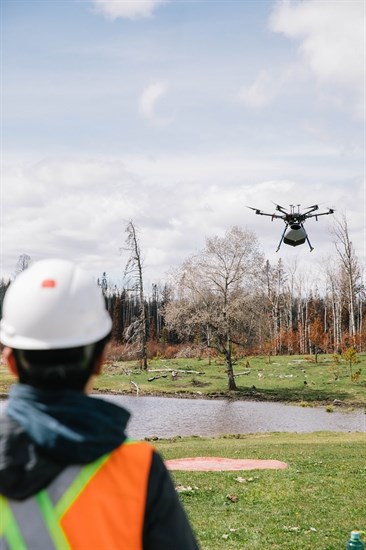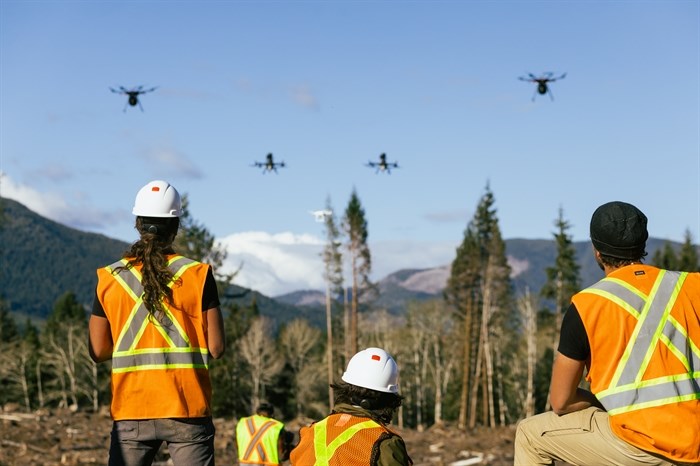
Flash Forest drones are replanting a part of the are burned by the White Rock Lake Wildfire northwest of Fintry in 2021.
Image Credit: Submitted/Flash Forest
May 15, 2023 - 7:00 AM
It’s common during wildfire season to see huge aircraft dumping water and retardant over burning forests.
Now, much smaller drone aircraft are coming to help plant trees in areas devastated by the White Rock Lake Wildfire in 2021.
It burned more than 83,000 hectares from the west side of Okanagan Lake north of West Kelowna (where more than 80 homes were destroyed) to Monte Creek (where two dozen homes were destroyed).
READ MORE: iN PHOTOS: The devastation left behind by the White Rock Lake wildfire near Vernon
This week, Flash Forest, an Ontario-based company co-founded by two Kelowna brothers, is starting to replant some of the burnt forest using drones firing seed pods into the soil from 15 to 40 metres above.
They’re working in an area that’s a 45-minute drive northwest of Fintry. Cameron Jones, the company’s chief operating officer, didn’t want to say exactly where because they don’t want people going out to watch.
They expect to produce 245,000 trees for the planting session, although they will be planting more seeds than that to ensure that many survive.
The work will take five to six days.
“They will be embedded into the soil,” Jones explained. “We deliver these very fast from the air in a way they can actually get into the soil, deep enough that they are protected from the elements and it’s easier for the lateral root to germinate.”

Image Credit: Submitted/Flash Forest
Seeds are strictly regulated so they have to be collected from the Okanagan, processed in a plant then brought back to be fired into the soil.
“We’ve created a pod that can rapidly germinate,” Jones said. “It holds moisture onto that seedling in periods of drought. We found that our pods do 336% better than bare seed if there is drought or heat domes and that’s a big issue you face in the Okanagan.”
The large numbers of forest fires in the region also has an impact on replanting.
“We try to determine where wildfires are going to occur over the next few years,” Jones said. “The Okanagan is a good example because they get a lot of fires so those tree stands and the seed availability is getting seriously impacted by it. We try to collect the seeds so we can be a first responder for those sites and make sure they come back.”
The big advantage to drone planting is not only how fast it can be done – a tree planter using a shovel can do only about 1,500 plantings a day – but also accessibility.
“We try not to go into the site,” Jones said. “We don’t want to disturb the ground. We don’t want to put our planters at risk because we’re planting in high severity burns.
“It’s very dangerous territory. You have a lot of snags. You have damaged trees that do fall over and, occasionally, they can hurt or even kill tree planters so we try to keep all our crews at a base and we send out the drones as far as we need to get to those planting sites without disturbing the ground.”
The drones range up to two kilometres from their base and crews can position themselves in safe areas to replace batteries and reload with them with up to 8,000 seed pods for each drone.
The drones can also plant on steep slopes where humans can’t safely go.
The area to be planted is scanned in advance to determine the best places to plant, avoiding things like rocks, streams and caribou herds. Flight paths are designed and operators can handle multiple drones at a time.
Once the White Rock Lake Wildfire area is planted, Flash Forest will move to sites in Alberta and Northern BC before returning near the end of June for a smaller planting in the higher elevation Lees Lake Wildfire area near Big White.

Image Credit: Submitted/Flash Forest
“You need to plant during the spring,” Jones said. “You’ve got to time it to so you get spring rains and that it gets enough sun and heat to establish strong roots that will last it through the winter.”
And, of course, planting can’t start until the snow is gone, which is why Lees Lake will be done later in the spring.
While drones have their use, they won’t be replacing manual tree planters in the foreseeable future.
“The demand is so high,” Jones said. “We lost over one million hectares, I think, of forests in 2021 in BC. Those sites don’t have a legal obligation to plant because they weren’t harvested. Those are just coming back as brush grass. So, the demand is super high. We’re just providing another tool to accelerate reforestation.”
Flash Forest is the largest of maybe three drone planting companies in the country, Jones said. He started it with his brother Bryce and Angelique Ahlstrom, who hails from Nelson. It’s based in Mississauga.
The company is working with Telus on the planting projects. Telus made an $11.4 million investment to help Flash Forest achieve its goal of planting one billion trees by 2028.
Learn more about Flash Forest here.
To contact a reporter for this story, email Rob Munro or call 250-808-0143 or email the editor. You can also submit photos, videos or news tips to the newsroom and be entered to win a monthly prize draw.
We welcome your comments and opinions on our stories but play nice. We won't censor or delete comments unless they contain off-topic statements or links, unnecessary vulgarity, false facts, spam or obviously fake profiles. If you have any concerns about what you see in comments, email the editor in the link above.
News from © iNFOnews, 2023